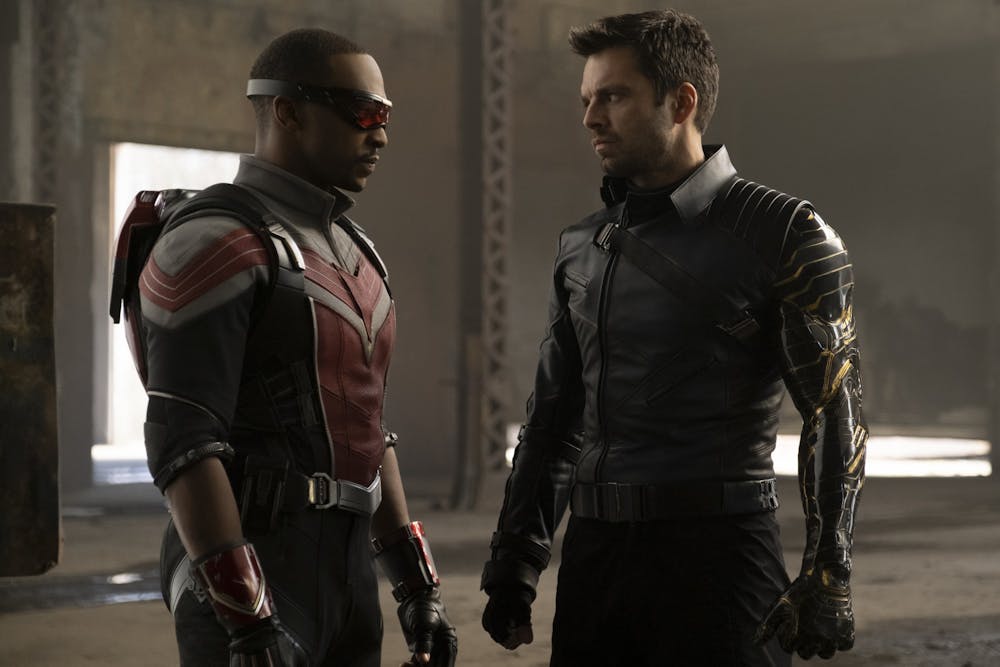In contrast to Marvel’s deep dive into Wanda Maximoff’s grief in the hit show “WandaVision,” “The Falcon and the Winter Soldier” fleshes out another important, but overlooked, aspect within the Marvel Cinematic Universe — racism.
“The Falcon and the Winter Soldier” hits the ground running in episode 1, providing a look into the character Falcon known by the name Sam Wilson, and how his personal life and celebrity status affects his day-to-day interactions. Black heroes and army veterans know life as a hero does not change the color of your skin, and Sam finds this out quickly.
Marvel’s expedition into the racial tensions of the U.S. begins with Sam and his sister, Sarah, applying for a small business loan. The loan officer seemingly recognizes Sam but thought he played basketball for the state college. This case of mistaken identity may appear small, but the comparison indicates to audiences exactly what type of interaction this scene was going to portray — a racist one.
After asking a series of irrelevant questions and taking two selfies, the loan officer reveals that the bank would not approve Sam for a loan. The main reason given by the loan officer was Sam had no income over the past 5 years, despite the fact he didn’t exist due to the events of “Avengers: Infinity War,” and Sam’s current military contracts as Falcon. Apparently, the event, known as “the Blip,” “constrained” the bank's resources.
Sarah sits beside Sam with a look of absolute disgust, a look that the Black community notably utilizes whenever racist stuff is occurring. About 46% of Black-owned businesses loans get approved in the U.S., according to the Federal Reserve, and being an Avenger does not make Sam an exception to this statistic, even in the Marvel universe.
The opening sequence of episode 1 shows Sam donating Steve Rogers’ vibranium shield, given to him at the end of Avengers Endgame, to the Smithsonian for the Captain America exhibit. After the ceremony, a government official tells Sam that he “is doing the right thing” by donating the iconic shield. This interaction appears straightforward at first, but by the end of the episode the shield is given to a white soldier named John Walker.
This hurts Sam, as the last remaining memory of his friend Steve is now with someone Steve never met, just because he’s white. Steve himself chose Sam to continue the legacy of Captain America, and the U.S. government denied his wishes because they couldn’t handle a Black Captain America. The decision to replace Sam with John was purely political as John had no powers nor any experience being a superhero, just a polished military resumé.
This isn’t the first time in the show that the U.S. government screws over a Black man who has committed himself to fighting America’s enemies. Episode 2 introduces Isaiah Bradley, the first Black Captain America. It’s even revealed that Bradley was the only person able to stand toe-to-toe with Bucky, the Winter Soldier, taking a chunk out of his metal arm in the process.
How did the U.S. government repay Isaiah for going on this suicide mission? By locking him up and experimenting on him for 30 years for avenging while Black. Isaiah’s experiences being a lab-rat and eventual scapegoat for the U.S. government parallels America’s history of neglect and experimentation of Black people. Some instances include the Tuskegee syphilis experiments and early-forms of gynecology research relying on the brutal testing of Black women.
When Sam asks Bucky why he didn’t tell Sam or Steve about Isaiah, the former winter soldier says it best –– “He’s been through enough.”
Just moments after this line was uttered, two police officers rolled up on Bucky and Sam. They immediately ask if Sam is bothering Bucky and ask for his ID. The exchange ends with Bucky having a warrant out for his arrest. Cinematographer P.J. Dillon emphasizes the regularity of this type of exchange with a shot of the neighborhood, as residents appear unphased by this blatant abuse of police power.
Watching the first two episodes created a feeling I had not experienced when watching a Marvel project before — disgust and uneasiness. Not with the show itself, but what is depicted during the two 49-minute episodes. The scene with the police was particularly upsetting as it could have taken a dark turn very fast, and in that moment not even Falcon would be able to fly his way out of danger.
Individually, these scenes can be taken as misunderstandings or unrelated errors on the part of the white people responsible, but together they illustrate the story of being Black in America. The government trusts Sam with high-level military clearance, but not to be the symbolic face of a nation in which white people are projected by the U.S. Census to be a minority to all other groups combined by 2045.
Marvel has taken television to new frontiers with their Disney+ series. If the commitment “WandaVision” has to portraying mental health is any indication, “The Falcon and the Winter Soldier” will continue to explore racism within the Marvel Cinematic Universe.






